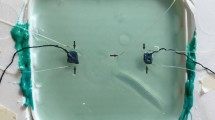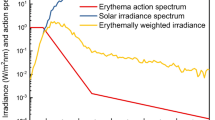Abstract
The purpose of this study was to evaluate the comfort of PET clothing treated by UV. The physiological responses of the human body were investigated. Mean skin temperature and physiological signals such as Electroencephalogram (EEG), and heart rate (Electrocardiogram, (ECG)) were examined for 20 minutes during stable wearing conditions. Mean skin temperature was measured every two seconds using Ramanathan’s method. Physiological responses were measured using Biopac MP100 series and analyzed using the software, Acqknowledge 3.5.2. Psychological effects were analyzed every five minutes. Comfort of untreated PET clothing decreased with the passage of time. Compared with PET clothing untreated, treated for 30 minutes, and treated for 90 minutes, the analysis of EEG showed that PET clothing treated for 90 minutes was the most comfortable after 20 minutes. In addition, the interval of the heart rate shown on the ECG was the highest in PET clothing treated for 90 minutes. Skin temperature was the lowest in PET treated for 90 minutes. We thus conclude that suitable UV irradiation would improve comfort.
Similar content being viewed by others
References
B. C. Min, S. C. Chung, E. J. Sung, H. J. Jeon, and C. J. Kim,Korean Journal of the Science of Emotion and Sensibility,4, 23 (2001).
G. S. Cho, C. J. Kim, J. Y. Cho, and J. Y. Ha,Fibers and Polymers,6, 89 (2005).
www.textile.hyosung.co.kr/kor/products/fabric_aerocool.html, 2003-04-25.
H. Y. Choi and J. S. Lee,J. Korean Soc. Clothing Textiles,29, 561 (2005).
H. Y. Choi and J. S. Lee,J. Korean Soc. Clothing Textiles,29, 617 (2005).
B. K. Park, “Surface Modification of Fabric Polymer”, The Korea Dyeing Technology Center, 2003.
H. Y. Choi and J. S. Lee,Korea Living Science Association,15, 275 (2006).
C. J. Kim, B. C. Min, M. C. Whang, K. S. Kim, H. J. Yang, and S. H. Oh, “Development of Synthetic Physiology Signal Measuring and Analyzing System”, Korea Research Institute of Standards and Science, 1998.
R. Cooper, J. W. Osselton, and J. C. Shaw, “EEG Technology”, Butterworths & Co., Ltd., 1980.
J. E. Kim, Y. S. Park, A. R. Oh, S. S. Choi, and J. H. Sohn,Korean Journal of the Science of Emotion and Sensibility,1, 153 (1998).
H. Y. Choi and J. S. Lee,Fibers and Polymers,7, 442 (2006).
Author information
Authors and Affiliations
Corresponding author
Rights and permissions
About this article
Cite this article
Choi, H.Y., Lee, J.S. The physiological response on wear comfort of polyethylene terephthalate irradiated by ultra-violet. Fibers Polym 7, 446–449 (2006). https://doi.org/10.1007/BF02875780
Received:
Revised:
Accepted:
Issue Date:
DOI: https://doi.org/10.1007/BF02875780




